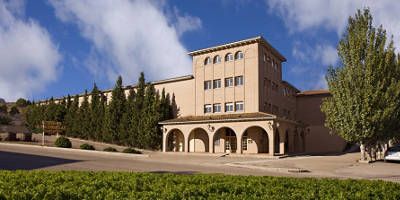| Type | Red wine |
|---|---|
| Region | |
| Grapes | |
| Producer | |
| Allergens | Contains sulfites |
| Alcohol contenti | 14.5% |

Coto de Hayas Garnacha Centenaria
2023Spec sheet
The wine
Coto de Hayas Garnacha Centenaria is an essential reference wine for any fan of Grenache wines. Made with hand-collected grapes growing on very old vines and producing less than 1 kg per plant.
What does this wine taste like?
What stands out about Garnacha Centenaria is the perfect integration between fruit and wood. Strawberries, cherries and blackberries delight the nose, alongside aromas of undergrowth and dry aromatic herbs. Hints of pepper and cloves appear embellished with fine toasted and smoky touches thanks to its time spent ageing in wooden barrels.
Offering a silky mouthfeel and magnificent acidity, it is both juicy and fresh. A relatively intense wine whose suggestive and sharp fruity and floral aromas reinforce its varietal character. Smooth to start out with, it delivers a full, harmonious and well-structured wine, extremely rich in nuances.
| Light | Bold | |
|---|---|---|
| Smooth | Tannic | |
| Dry | Sweet | |
| Soft | Acidic |
View | Morello cherry red / Clean / Bright |
|---|---|
Bouquet | Higly aromatic / Fresh fruit / Floral notes / Spices / Toasty notes |
Mouth | Smooth / Voluminous / Full / Balanced / Long |
Drinking and storing
Best served in a high glass at a temperature around 16ºC. Maintains all its qualities for up to 4 or 5 years after the harvest date, or perhaps even longer.
Food pairing
Grilled pork is one of its favourite partners, especially for a fatty piece of meat seasoned with spices and aromatic herbs
Roasted pork / Lamb with fine herbs / Grilled meat
Ratings and awards
| 2020 | 90 PK | |
|---|---|---|
| 2018 | 91 PK | |
| 2015 | 90 PK | |
| 2014 | 90 PN | |
| 2013 | 90 PN | |
| 2012 | 91 PN |
Wine critics reviewsReviews by Parker
Customer reviews
Winemaking
The grapes used to create Coto de Hayas Garnacha Centenaria are usually harvested in the first week of October. The wine is then made using traditional methods. Grapes undergo a cold maceration for 24 hours to preserve the fresh aromas of the fruit, followed by fermentation at a controlled temperature of 26º C and ten days of maceration. Once the desired profile has been achieved, the liquid is bled and pressed. The wine then spends four months on its lees in French oak barrels where malolactic fermentation takes place and its intense fruitiness is highlighted and rounded off.
| Vinification material | Wood |
|---|---|
| Ageing period | Between 3 and 4 months |
| Type of wood | French oak |
Vineyards
Pagos de Monte Alto y La Sarda
Hundred-year-old goblet vines growing in the Monte Alto and La Sarda plots. Dry and arid soils of slate and red clay, with vines planted on terraces on the hillsides of the Iberian System range in the foothills of the Moncayo mountain.
| Vine age | 100 years |
|---|---|
| Soil | Clay / Slate |
| Climate | Continental |
| Yields | Low yields |
The winery
Bodegas Aragonesas

Bodegas Aragonesas was founded in 1984 when several cooperatives in the Campo de Borja region decided to unite to market the wines they were producing. The intervening years have seen this winery grow in prestige and recognition globally due to their Coto de Hayas brand, their star variety Garnacha used in the production of many wines, often originating from extremely old grapevines, and the careful management of their extensive vineyards has not gone unnoticed either. They...
























